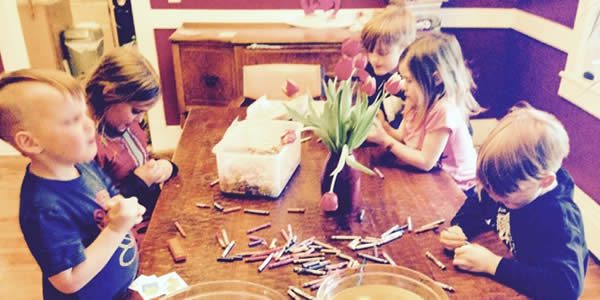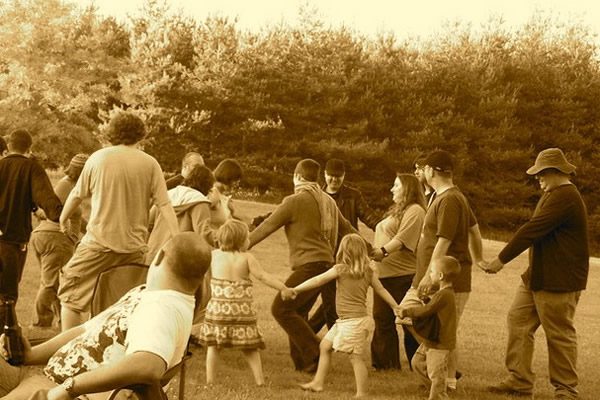“I want to talk to you about children’s programming.”

I hear that a lot. I heard it last weekend when a small delegation from a grove in Indiana visited my grove for our Lughnassadh celebration. I sat down with a couple of earnest childless young people, to attempt to distill decades of knowledge into a twenty minute spiel. They were both enthusiastic liturgists, knew more about the epithets of Brigid than I do, and sang a song in Gaelic together in beautiful harmony. Needless to say, I was impressed. But all the knowledge of lore in the world won’t teach you what to do with a stubborn three year old who wants attention.
I’ve taught a number of workshops on kids and paganism over the years. I’ve been asked questions about whether or not we will brainwash our children by raising them in our religion (we won’t), and how to integrate young children into deep trancework (you probably shouldn’t). I’ve been working with kids since I was a teenager. I’ve been a Senior Girl Scout, an Outdoor Aide, and Girl Scout Leader. I studied child development in college, volunteered as a tutor, and worked in a daycare, along with raising my own two precious children and helping to raise a passel of other. So I know a thing or two about kids.
Having said all that, here are a few of my thoughts on how to integrate children into ritual.
All Kids Are Not Created Equal
Or: Knowledge is Power
When you have kids coming to a ritual it’s really good to know a couple of things:
- How old are they?
- What grade are they in?
- Do they have food allergies?
- Are their parents responsible?
- Do the kids want to be coming to ritual?
The first two will tell you how to focus your integration process. Teenagers are going to be a lot different than school age kids, of course, but there is also a huge difference between a second grader and fourth grader. Age and grade level will give you a general idea of what they are capable of and will aid you greatly with the magic of google-fu. Try googling “spring craft project” and you will get a lot of links to a lot of things. Try googling “spring craft project for fourth graders” and your search time will be greatly reduced. This will also help you pinpoint how the kids can interact with ritual, which I will talk about in a minute.
Food allergies are a thing these days. If you have issues with it, get over it. Food allergies have skyrocketed and you don’t want to be the one who feeds little Timmy peanuts, you want to ask. Adults are capable of fending for themselves, but even the most responsible parent can lose a kid in the thronging crowds of an after ritual potluck. Ask and share that information, especially if the kid is young or has a particularly severe allergy.
The fourth question is not something that you can directly ask a parent. “Hey Bob, would you call yourself a responsible parent?” Yeah. That’s not productive. But you can clue in by asking around, gently. If you know someone who knows the parent, talk to them about their interactions. Explain that you are trying to prep for the upcoming ritual and maybe throw out some age appropriate ideas and see if the person thinks the kid would be up for it. Often you can get some good feedback, but remember the source. If Jim happens to be righteously childless and likes to talk about “Breeders” his feedback might just be tainted. Often you can tell a lot just by emailing or talking on the phone to a parent beforehand. An interested and involved parent is a responsible parent. If you don’t have kids, remember: parenting is hard. Even those who desperately wanted parenthood can have bad days.
The fifth question addresses motivation. I’ve seen three main scenarios. One: the kid is genuinely interested in spirituality and wants to participate. Two: the parent is genuinely interested in spirituality and the kid is along for the ride. Three: the kid wants to come because there is a friend/girlfriend/inexplicable-longing that is also attending. Door number one is the best case option, but the other two can work as well if you are able to be flexible. The answer to this question often varies from event to event. When my kids were little they stayed at home with Dad. As they got older they started to come to events and it was very exciting. They wanted to be involved and do everything I did. It was a lot of work, but it was also awesome. Now they have friends who come to grove and I have a tween. They tolerate a certain amount of structure and then they have to go off and do tween things. It’s actually kind of adorable, but don’t tell my eldest.

Rule number one of Kid Club is: Don’t Suck
Or: How to be Interesting to People with Different Developmental Needs
Now that you are armed with information from the aforementioned questions you can move forward with your integration of children into the ritual space. I’m going to give you a very quick rundown of the various developmental stages and how children in that group might be able to participate. This is just the tip of the iceberg of a very large topic. There are people who are experts in getting children to do amazing things. They are called Teachers and are greatly underpaid and underappreciated. If you are lucky enough to know one, you might ask them for help.
Babies:
These tiny creatures are quite helpless and needy. No, they are not crying to get attention, they are helpless, have no words, and need lots of help, lest they die. So they cry. However, prolonged crying can really wreck a ritual. At this age, the main job of the ritual leader is to support the parent in their work and to make sure that everyone is clear on boundaries. Make sure to mention beforehand that you would appreciate it if the parent will take the baby out of circle if they are crying excessively. Support the parent’s choices. Do not tell them that they ought to be breastfeeding. If they are breastfeeding do not tell them that you think it’s weird and sexual. (Yes. I had that happen.) Have a space nearby where babies and parents can hang out, maybe a blanket or a comfy chair. Make sure they know where things like changing stations or hot water for formula can be found.
Toddlers:
As they become mobile and verbal children are in a dangerous place. I like to call this the “Cliff-Flinging Stage” because this is the age when they just don’t know better, have endless energy, and like to stuff things in their mouths. Ritual with toddlers can be hard, but it can be done. Put away that fancy glass candleholder and your blackthorn athame. Think non-breakable. Wood is a good natural material, as is stone. Be careful with flames. Parent responsibility is at its height here. Parents of a toddler who want to be able to experience ecstatic union with the divine during the rite are fooling themselves. They need to be focusing on little Lily and her need to stuff quartz points into her mouth like a psychic chipmunk. Make sure to communicate dangers and the need for vigilance beforehand. Simple crafts can work well here. Also, a play space to the side of the circle can be distracting and good. Using spray bottles for purification is a great way to get little ones involved. Anything tactile and full of movement is great. Bubbles, ribbons, bells, simple songs, and dances work well.
Preschoolers and Kindergardeners:
These are four and five year old kids. They are quite a different game than two and three year olds. They can express ideas, follow simple directions, most of them can focus on something dull like ritual for at least a little while. If you are lucky, they might even sit patiently through a whole boring talky ritual. That’s the thing. A lot of ritual is a lot of talk. Obscure talk about weird things they don’t have a lot of experience with. Make your rituals multisensory and movement oriented for these little folks. Remember that they have a much shorter attention span than an adult. That’s how they are built and expecting anything else is like expecting everyone to be an astrophysicist. Sure, you get someone like that every once in a while, but most of us just like looking at photos of Pluto. Coloring pages are still a little beyond these guys, blank paper is better. Crafts are great but messy. Snacks are vital to sanity. It’s good to think of them like cats. Let them wander where they want to go, steering them away from dangers. They’re usually capable of taking direction from trusted adults, so I have noticed that the village helping to raise the child really kicks in here. I remember my little one wandering off at one festival and I alerted my grove. Everyone stopped what they were doing to go help find my four year old. I was part of a family in that moment, and it was beautiful. The Rev. Kathleen Pezza has written a beautiful liturgy entirely in song that is perfectly suitable for kids this age and older on into elementary school.
Lower Elementary or First Through Third Grades:
Now is the time to glory in glue and scissors! Behold the beauty of Pinterest and the wisdom of pipe cleaners. When people without kids think about kids, this age group is what they usually think of. It’s all about adorable little kids making bird feeders out of pinecones, peanut butter, and bird seeds. This is the time when you can really begin to explain what it is that you are trying to do with this whole “ritual” thing. Discussion about deities can be interesting and fun, especially if you relate it back to their lives. It’s actually really neat if you can find a craft project, a coloring page, and maybe a story for them that all relate to the seasonal theme. There are lots of options for working school age kids into ritual. Thinking about seasonal traditions and using them as the working can be fun. We’ve bobbed for apples at Mabon, done a tug of war of the powers of water and fire for purification in spring, and made milk jug skeleton masks for Samhain. Look at the folk traditions that surround the culture you are focusing on and use them as part of your ritual. Let kids take part in ritual with an adults help. Expect that they may still get bored and wander off. We are not brainwashing our children. That is okay. Setting up a station with coloring pages and stickers can help keep them occupied while parents finish up thanking the Gods.
Upper Elementary or Fourth through Sixth Grades:
Things begin to change in the Upper El. Seismic tremors of hormone cascades and logical reasoning are happening simultaneously. They are able to think about things rationally as concrete operations kick in from ages 7-11. Discussions can deepen, history becomes more interesting and their depth of wisdom can be remarkable. However you can’t forget those hormones. There will be times when they want nothing at all to do with ritual. I’m deep in this territory right now with my grove and it’s a delicate balance of offering options, respecting a negative response and occasionally bribing them to participate. (I’m a mom. It’s a time-honored tradition.) It works best when I involve them in the planning. Having a group of children that are doing activities together can work really well and be a big motivator. The tug-of-war between self-direction and adult led activities can be hard to navigate. It’s important to listen to the kids and help them develop activities geared toward what they are interested in.

Remember: children are little bundles of chaos and wonder. Appreciate where they can lead you, and don’t be afraid to dance and sing with them.
Peace out, and good luck, Dear Reader.

Patheos Pagan on Facebook.

the Agora on Facebook
Dandelion Seeds is published on monthly on the first and third Wednesday. Subscribe via RSS or e-mail!
Please use the links to the right to keep on top of activities here on the Agora as well as across the entire Patheos Pagan channel.














